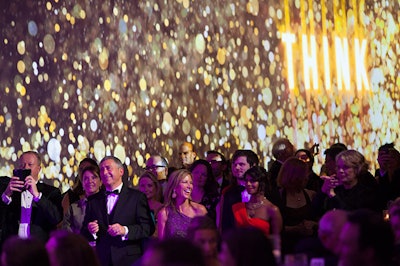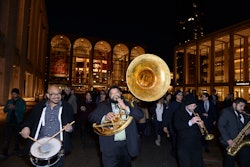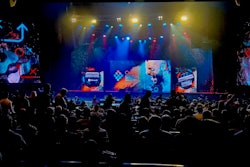
 Exclamation Group co-founders Thomas Serrano and Anastasia NisenbaumPhotos: Courtesy of Exclamation Group
Exclamation Group co-founders Thomas Serrano and Anastasia NisenbaumPhotos: Courtesy of Exclamation Group
“I was fascinated by how opening ceremonies change the mood of people who live in the country,” she explained, noting that locals often start out frustrated by closures and traffic when the Olympics come to their city. But from her research, she found that regardless of location, the opening ceremony shifts their perception to a positive one.
“The opening ceremony is there to tap into the emotions of the audience all over the world—and for the city and country that hosts the Olympic Games, it taps into a deep pride,” Nisenbaum said. “And that’s exactly what we’re doing on a small scale with our events.”
Tapping into emotions is something the team at Exclamation Group is deeply passionate about when producing events for clients like L'Oréal, Swarovski, Hublot, Bulgari, and Dom Pérignon. “It’s about taking a relationship that at the beginning is sometimes transactional, and in the end making sure it’s about curiosity, about how much [attendees] learn about the brand, and how they feel a connection with a brand,” added co-founder Thomas Serrano.
The team described this process as “mapping the emotional journey of the audience.” The approach uses a calculated combination of entertainment, recipes, color, architecture, and sound to tap into guests’ senses to reach the ultimate goal of the event—and, hopefully, give guests goosebumps in the process. “It could be through an intimate conversation with a CEO, or a surprise moment, or just the perfect dish or the perfect fireworks display—but it’s all about that cumulative moment that triggers several emotions,” said Serrano, who was inspired to take this approach after a conversation with a Broadway producer, who described how a good script should strategically take guests on an emotional journey.
We chatted with Serrano and Nisenbaum to learn their best tips for generating these meaningful emotions in event attendees. Here's what they had to say…
1. Offer multiple emotional touchpoints throughout the gathering.
“Before you map the emotional journey, you need to map the actual event’s timeline and think about the mindset of your audience through the entire process,” Serrano explained. “When are you going to have those emotions come up?” For example, he noted, when you’re welcoming guests and encouraging them to gather and start socializing, this may not be the right time to impose any big emotions on them.
But that doesn’t mean all emotions should be neglected during these small moments, Nisenbaum added. “When you welcome them and they see a smile on your face, it brings a good mood already. They start on a nice note, and that can determine their evening after.” Continue growing those moments throughout the evening, Serrano said. “We try to have multiple touchpoints that build the momentum into deeper emotion and connection. Try to finish on a higher note than you started," he suggested.  Other highlights of the L'Oreal event included a gospel choir greeting and a customized show performed by 45 singers and dancers interpreting famous songs of Broadway shows. "It’s that mix of creativity that makes the event so unique," said Serrano.Photo: Courtesy of Exclamation Group
Other highlights of the L'Oreal event included a gospel choir greeting and a customized show performed by 45 singers and dancers interpreting famous songs of Broadway shows. "It’s that mix of creativity that makes the event so unique," said Serrano.Photo: Courtesy of Exclamation Group
2. Consider a mix of personal and collective emotions.
Serrano also noted the difference between personal and collective emotions, and stressed the importance of each. “At the beginning of the event, maybe they’re invited to go to an exhibition, which is a personal journey. But then at the end, they’re gathering for a dinner, and that’s where you’ll have those collective moments.
“It could be as simple as a moment of serendipity or a pure moment of joy,” Serrano added. “It’s usually around pleasure, but could also be moments of nostalgia. We [hosted an event with] Aretha Franklin, and we saw a woman crying because Aretha was entering the room. That’s the nostalgia. So we’re also mapping the level of excitement we want to give to guests throughout the journey. It’s all about balance and rhythm.”
3. Be intentional about active participation versus passive participation—and think carefully about what works for your specific audience.
While mapping the event, the team also considers when they’re seeking active versus passive participation. “Am I asking for more passive participation, where they’re just witnessing the beauty of the room—which can certainly contribute to a specific emotion—or am I asking them to be part of something more interactive?” Serrano asked.
He cited a recent example where the team was designing an immersive theater experience for a new product launch, where guests would potentially be prompted to sing with professional actors. The key is understanding the client and the audience to learn what they’ll be comfortable with. “There’s always a risk that something won’t work, or won’t resonate with the audience. Some clients are comfortable with the risk, and some are not,” he explained.
In another recent example, at a lunch for a high-end jewelry brand, the team leaned into active participation by hosting a class about high-end jewelry. “That type of interaction is very different than if we did just entertainment after dinner,” Serrano noted. When deciding between the options, “We try to have a rationale for it to make sure we’re always hitting the key milestone from the client.”  Sometimes, the simple beauty of a room can generate emotions. For a two-day Swarovski event that showcased its Crystal Galaxy collection, Exclamation Group started with a clean, white space—and then surprised guests by transforming it with a full Crystal Galaxy theme the following day. The event also hosted the surprise reveal of Swarovski’s new face for its global campaign, Karlie Kloss.Photo: Courtesy of Exclamation Group
Sometimes, the simple beauty of a room can generate emotions. For a two-day Swarovski event that showcased its Crystal Galaxy collection, Exclamation Group started with a clean, white space—and then surprised guests by transforming it with a full Crystal Galaxy theme the following day. The event also hosted the surprise reveal of Swarovski’s new face for its global campaign, Karlie Kloss.Photo: Courtesy of Exclamation Group
4. Make sure to study your audience demographics.
Nisenbaum also stressed the importance of deeply understanding who the attendees are—including their age group, interests, country of origin, and more. This can dictate things as simple as timing; the team recently worked with a client who wanted to have an after-party for an audience on the older side. “What is the percentage of people who would go to a party at 11 at night? You can organize a beautiful after-party, but there’s nobody there because it’s too late,” she noted.
She also emphasized understanding cultural differences, noting that Exclamation Group works with a lot of French brands—but often designs those events for American audiences, who may have different expectations. Added Serrano, “How do you make it true to a French or Italian brand, but have it resonate with an American audience? In Italy, you’d have dinner at 8 or 9 p.m. You don’t want to do that in the U.S., but you do want to give some hints at the heritage of the brand in other ways,” he said.
5. Lean into emotion-generating things like art and music.
A major way the Exclamation Group team likes to generate emotion and celebrate a brand’s heritage is through art, from paintings and sculptures to music and cinema. “We have the freedom to mix,” explained Serrano. “We can project a painting on beautiful architecture while there is some live classical music being performed by an orchestra, as guests are sipping on a new cocktail we made just for them. It’s that mix of creativity that makes the event so unique.”
He cited examples from the team’s own portfolio, like an event where guests were seated directly in the middle of an orchestra, or another where professional dancers performed just feet away from where they stood. “The guests will never do that again in their life,” he said.  For Van Cleef & Arels’ 45th-anniversary celebration, Exclamation Group tied the experience back to the brand via an 80-foot projecton screen that showcased live imagery of iconic California landscapes, all inspired by the jewelry. A runway stage was created in front of the projection wall, which hosted live musical performances along with models—who later walked through the crowd for guests to view the pieces more closely.Photo: Courtesy of Exclamation Group
For Van Cleef & Arels’ 45th-anniversary celebration, Exclamation Group tied the experience back to the brand via an 80-foot projecton screen that showcased live imagery of iconic California landscapes, all inspired by the jewelry. A runway stage was created in front of the projection wall, which hosted live musical performances along with models—who later walked through the crowd for guests to view the pieces more closely.Photo: Courtesy of Exclamation Group
6. Always tie it back to the messaging of the brand or event host.
Of course, these goosebump moments should always tie back into the event’s main goal. “Make sure that everything you deliver as an emotion is relevant to the messaging of your clients. It’s not just for the sake of getting people excited and joyful,” pointed out Serrano. “We’re not just here for pure entertainment; we’re marketers. How do we make sure these emotions are going to help us deliver a higher message, and help build a long-lasting relationship between the audience and the brand?”
7. Give them an experience they can’t get on their own.
Exclamation Group works on a lot of luxury events with seen-it-all guests who may not be impressed by something like a great meal or the chance to preview a product in a traditional way. It’s all about making them feel special, said Serrano. That can be done through something like individualized attention from a brand's CEO, for example; the team likes to lean into intimate events where proximity is important—whether it’s with an executive, with the entertainment, or with the product itself.
“Why would they join you? Do they really care?” asked Serrano, who believes that tapping into emotions is what can set things apart from other experiences attendees may have regularly. “Tapping into emotions allows you to make it so unique and special, and something the guest could not experience on his own,” he said. “It’s building a relationship. Emotions trigger more retention and loyalty.”



















